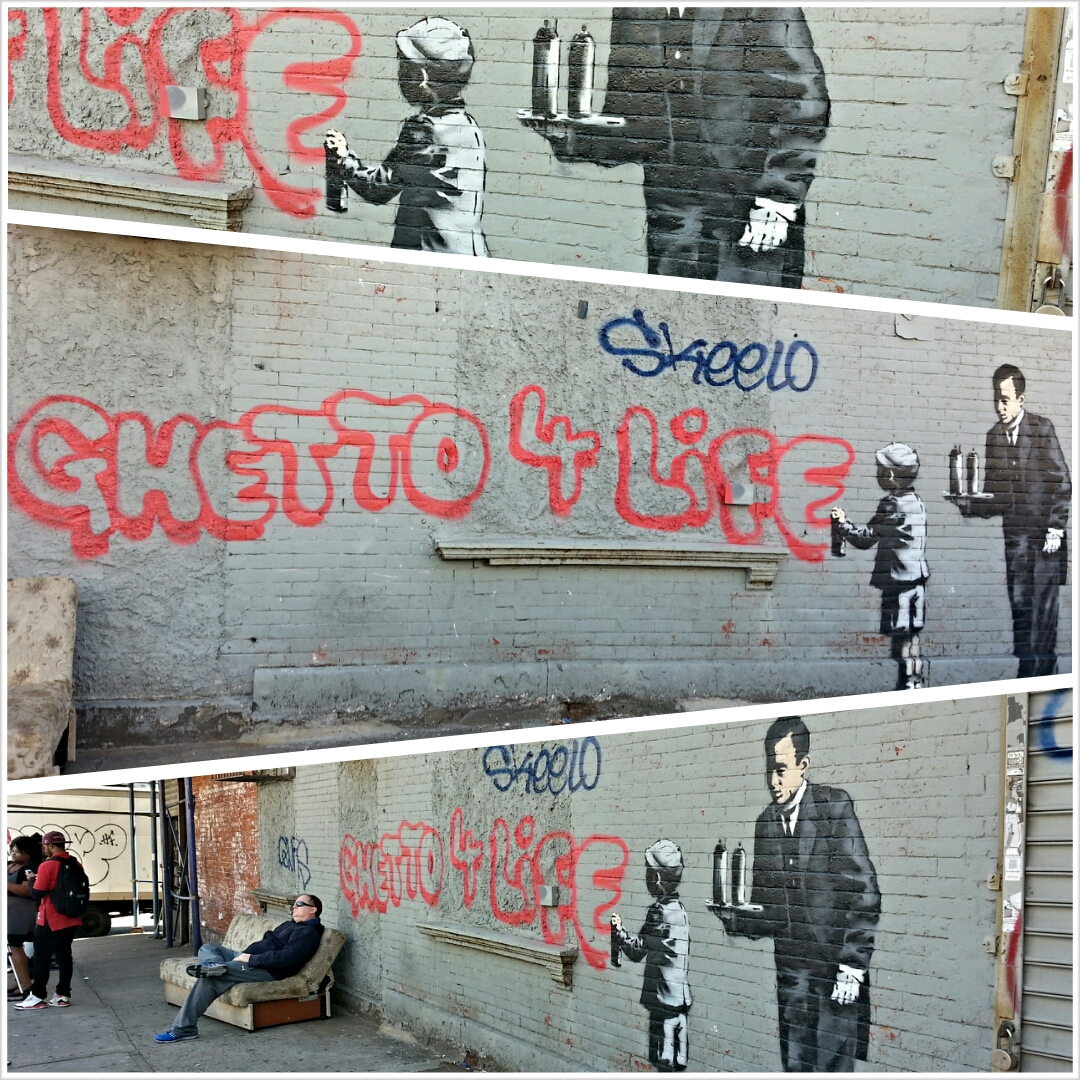
Banksy draws crowds to Melrose wall
When he unveiled a mural on the corner of East 153rd Street and Elton Avenue in Melrose, the artist Banksy touched off a heated debate over a single word: “ghetto.” The mural, which appeared on Oct. 22, showed a butler bringing a boy spray paint cans under the slogan “Ghetto 4 Life.”
Sustainable South Bronx may have sold t-shirts that say “Green the ghetto,” and others who live or work in the South Bronx may sometimes refer to their neighborhoods as “the ghetto,” but many didn’t like hearing that word from a white artist with no Bronx roots.
“When a white, billionaire British person like Banksy says ‘ghetto,’ it can sound offensive because it is associated with people of color, so he should have been more careful with the choice of words because the context changes the meaning,” said Jeffrey Guard, director of The Bronx Art Exchange, an organization that promotes art in the area.
Members of the graffiti art collective Tats Cru—who have taken Bronx art to the world over for the past two decades—are ambivalent.
“Overall I think it is a great piece,” said How, who along with his twin brother Nosm, is a member of Tats Cru, which is based in Hunts Point. “It is a powerful, critical yet satirical take to bring attention to the life of the so-called ‘minority’ neighborhoods, he said. “Banksy smartly provokes and so he creates a dialogue among his followers.”
But the fact that Banksy chose Melrose to paint “Ghetto 4 Life,” makes another member of Tats Cru uneasy. “Banksy didn’t do this in Queens; he didn’t do it in Manhattan,” said Bg183. “Why did he choose to do this in the Bronx? Of course, yes, we are a ghetto, but we are also more than that.”
Those who complained were right, said Bronx Borough President Rubén Díaz Jr., who issued a public statement denouncing the mural. Using the term “ghetto,” he said, was “throwing a wrench in our efforts to rebrand our borough.”
Ed Garcia Conde, whose popular blogs Welcome2Melrose and Welcome2theBronx, have hosted a series of arguments about the mural, wrote that he was less offended by the mural than by the crowds of mostly-white people from elsewhere in the city who flocked to the Bronx, “thinking how cool it is that a world renowned artist left his mark in Melrose and the heart of the South Bronx.”
Conde felt “insulted that with decades of major street art, murals and our own homegrown and world-renowned graf artists it took an outsider to bring folks in,” he wrote.
Bronxites encountered near the mural shortly after it was painted offered a variety of views.
Justin Dapena, a college student who spent some time staring at the mural, said he thought that sometimes a foreigner sees reality in a different way from locals. “Banksy came here, and he saw a ghetto,” he said. “Why make a big deal out of it? His mural doesn’t have to be ‘the’ truth. It is ‘his’ truth and that’s why I like the piece.”
As they looked at the painting, high school students Demaris Robinson, Justin Magg and Rosario Galilea, said they do live in a “ghetto,” but not the ghetto portrayed by Banksy.
“Caucasian people think that a ‘ghetto’ is a dirty place, with low class criminals,” said Robinson, but, for me, the ghetto is my home: it is not negative; it is part of who we are.”
But Magg said that while he found the technique too simple, “I like the ideas the mural conveys.” He explained, “It talks about a ghetto, and that’s what we are at the end of the day.”
Banksy doesn’t have the right to apply the term to the Bronx, argued CUNY community college student Romeo Colón. “We use the term ‘ghetto’ to talk about our neighbors, the people we know face to face, our community,” he said.
“There are sections of the Bronx that can be ghetto, but not all of it,” said Mildred Smith, 73.
And Roberto Charbonier, a 47 year-old mechanic, said, “It is disrespectful talking about a place and saying that all of it is a ‘ghetto.’ That sounds like discrimination.”
The conversation justifies the work, argued Tats Cru member How. The most remarkable aspect of the work, he said, is how much public discussion it has generated.
“Banksy has always proven to move people and encourage them to think,” he said.


Looking at it in it’s entirety;
The young White male represents the privileged class (see his butler) and the statement is representative of the glorification of the “ghetto lifestyle”. At the end of the day, although some people may find that lifestyle appealing, the reality is the harsh surroundings of communities like Melrose and the problems that exist.